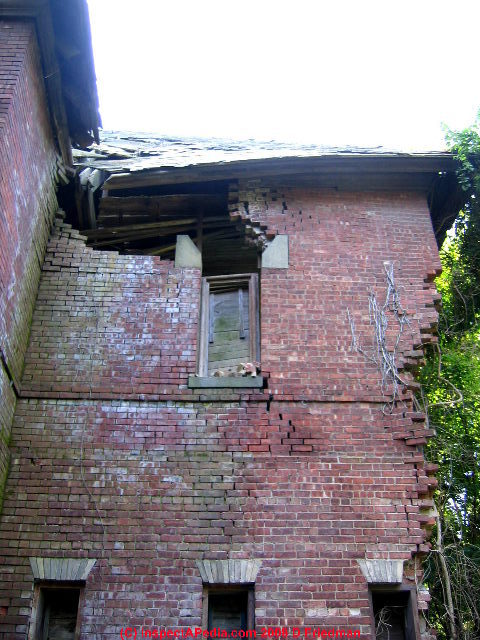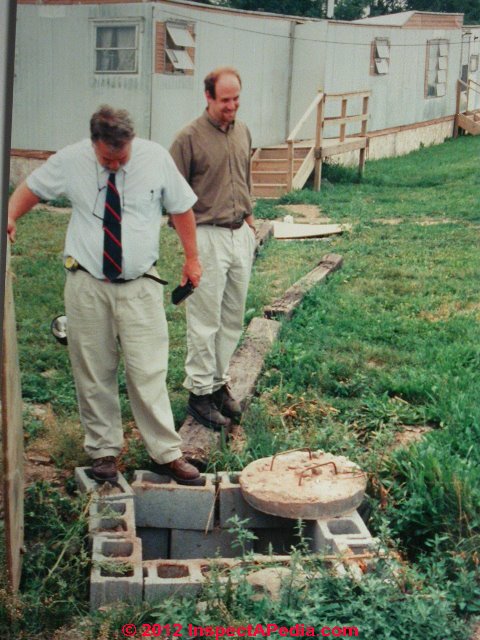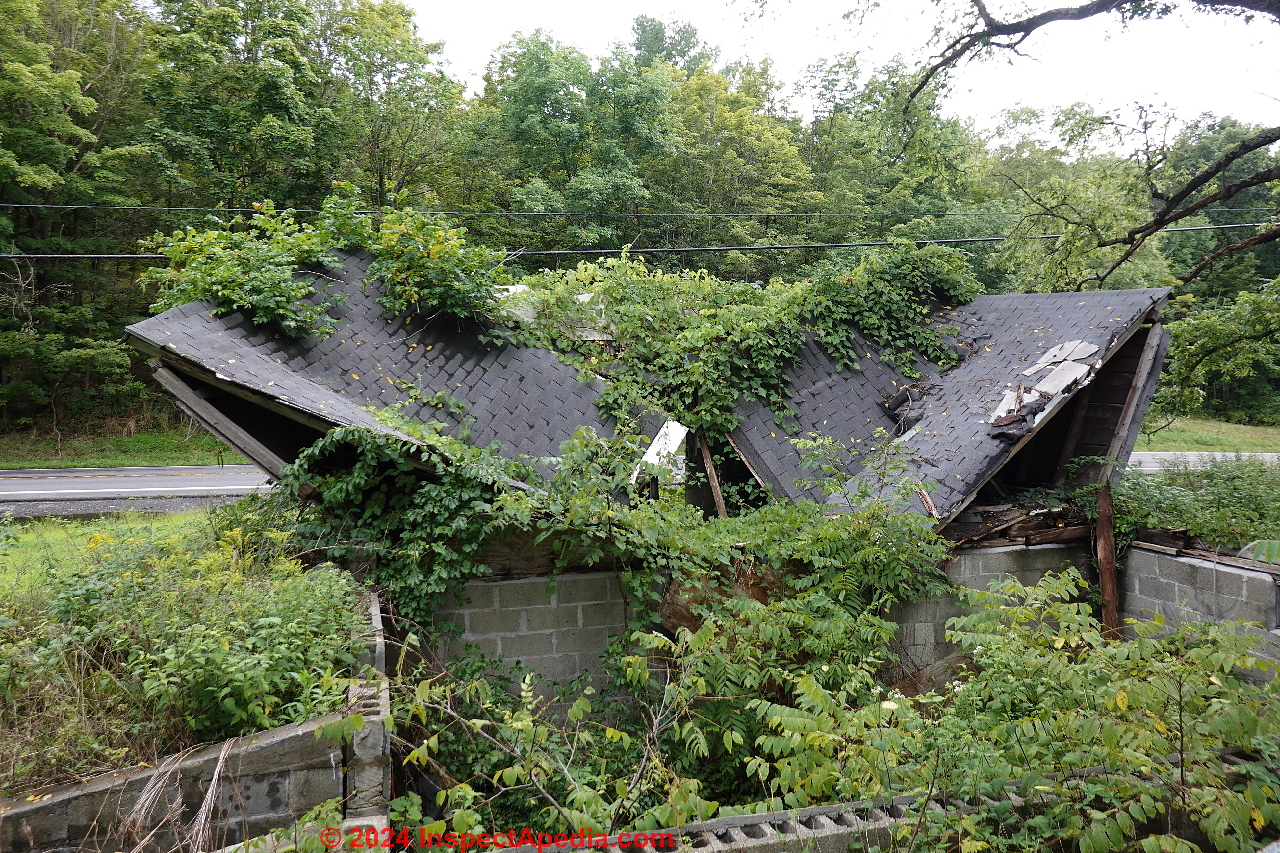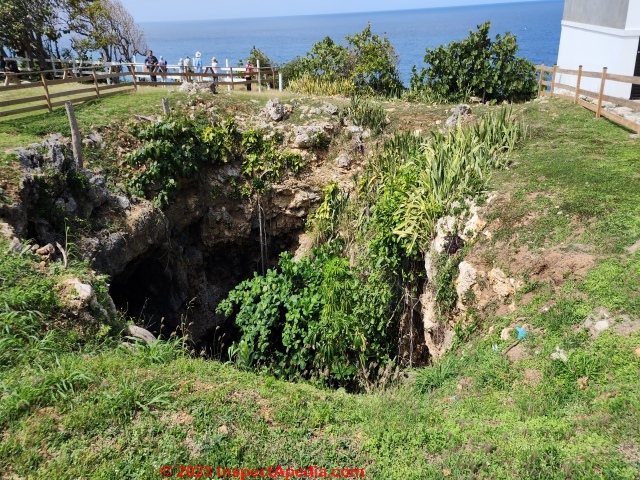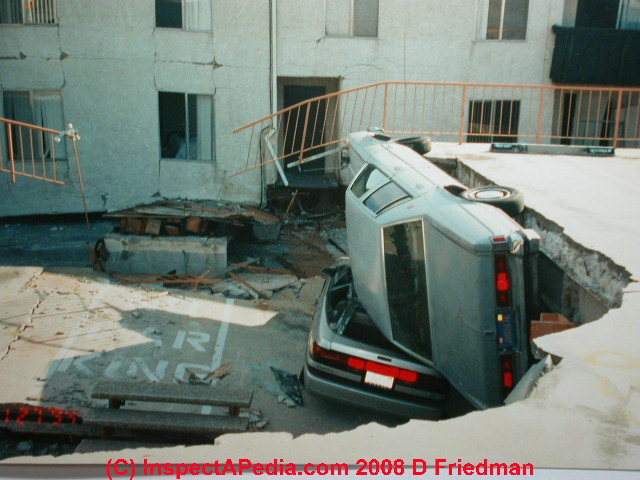 Structural Collapse Hazards
Structural Collapse Hazards
Special Risks to Building Occupants & Inspectors
- POST a QUESTION or COMMENT about responding to signs of risk of catastrophic structural collapse in or at buildings
Index to detailed descriptions of conditions found at buildings (foundations, framing, roofs and other structural systems) that might indicate risk of sudden catastrophic building collapse, risking injuries or even fatalities.
Watch out: if you suspect that a building is in danger of collapse, get people out and safely away from the structure and call emergency services for further help.
Page top photo: inconsistencies or errors and omissions in placement of steel rebar reinforcement in this parking garage slab probably explain why one particular section of this parking garage floor collapsed during the 1994 Northridge earthquake - inspected by the author.
InspectAPedia tolerates no conflicts of interest. We have no relationship with advertisers, products, or services discussed at this website.
- Daniel Friedman, Publisher/Editor/Author - See WHO ARE WE?
Building Structural Collapse Hazards
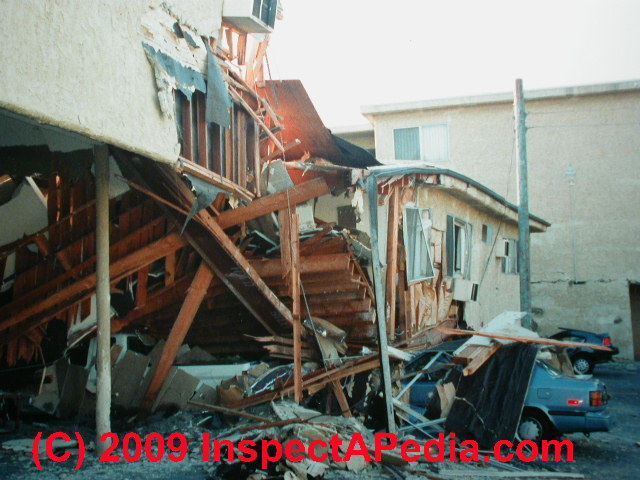 Here we provide brief summaries of examples of very dangerous collapse hazards at residential properties, followed by a more complete list of our in-depth articles describing nearly all such hazards that may be found at residential and light commercial buildings.
Here we provide brief summaries of examples of very dangerous collapse hazards at residential properties, followed by a more complete list of our in-depth articles describing nearly all such hazards that may be found at residential and light commercial buildings.
Photo: In an extensive survey of building damage following an earthquake, we found that in many instances serious collapses, injuries and even fatalities could be blamed on more than the quake itself: some buildings had been constructed improperly, perhaps in error or by someone taking a shortcut such as substituting hollow steel pipes for concrete-filled Lally columns.
Article Contents
- BRICK WALL / FOUNDATION BULGE - COLLAPSE
- DECK or STAIR COLLAPSE HAZARDS
- SEPTIC & CESSPOOL COLLAPSE RISKS
- WOOD FRAMED ROOF COLLAPSE HAZARDS
- LIST OF BUILDING COLLAPSE HAZARD ARTICLES
...
Examples of Catastrophic Structural Collapse Hazards at Residential Buildings
Brick Masonry Wall or Foundation Collapse Danger
Masonry structures such as the carriage house in Saugerties, NY shown above can be very unstable and risk sudden even imminent sudden collapse, depending on just how it is damaged.
Broken bond courses in brick are a particular concern as are severely-bowed masonry block walls. Discouraged about other inspection defects, SV's realtor kicked the brick foundation asserting that at least the foundation was salvageable. The building collapsed.
If you see a brick wall or foundation that is bulged, the situation may be extremely dangerous. Get out and call for assistance.
Details are at BRICK FOUNDATION & WALL FAILURES and COLLAPSES
...
Deck Collapse Hazards
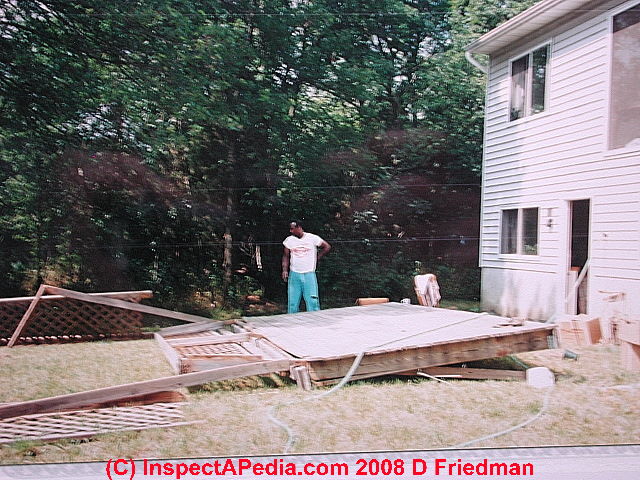
Noting that the deck ledger was not secured to the building and that the deck posts were not adequately connected to the deck's outer girder, the author inspected this deck and warned of its probable collapse, both orally and in writing, indicating that it was dangerous. He told the client to "stay off of the deck completely" until it was repaired.
The client moved into the new home, invited friends to celebrate, partied on the deck, and rode it to the ground as it collapsed.
Six people were hospitalized (none with serious injuries). Children playing below the deck as it collapsed ran to safety.
The author re-inspected the collapsed deck to photograph construction details that led to the structural failure of this component. Litigation was broached.
When we asked the client why, after we had told him that the deck needed to be fixed right away - before going onto it - he had instead had a party on the deck, his answer was "Well I didn't really understand what you meant by dangerous, collapse, and right away."
Building inspectors who warn of unsafe conditions need to do more than say it. Have sufficient conversation with the building occupants or client to be sure that they understand the danger.
Details are at DECK COLLAPSE Case Study
...
Cesspool / Septic Tank Collapse Danger
Above, our associate Steven Vermilye illustrates for an attorney the collapse risk at a septic tank in upstate New York.
We assisted in investigation of a tragic death on Long Island, New York: a new owner of a septic pumping contracting business sent an untrained septic pumper truck driver to a home with instructions to "clean the septic tank".
The home was served by a site-built cesspool made of stacked concrete blocks. Pumping such a cesspool is very likely to lead to collapse.
The worker emptied the cesspool and replaced its cover.
Later that afternoon the homeowner, curious to see what work had been done, walked outside and over the cesspool which then collapsed over him, resulting in his death.
Details are at SEPTIC & CESSPOOL SAFETY - Septic & Cesspool Collapse Hazards
...
Wood Framed Roof Collapse Risks
Above: This house roof in Craryville, New York, has collapsed inwards. A building roof structure that has been improperly built or damaged by leaks, rot or insects may stand for a long time but then suddenly collapse under an unusual load such as heavy wet snow or even simply the placement of bundles of shingles onto the roof in preparation for a re-roof job.
Unsafe roof framing or rotted sheathing can risk both structural collapse leading to serious injury or worse. They may present special hazards to inspectors or workers on the building as well as to building occupants.
At one of our re-roof jobs in the 1980s, our roofing assistant Donna Smith was walking across what looked like a safe asphalt shingled roof surface when suddenly she fell through roof.
Further inspection found that a roofing contractor had installed shingles over water-damaged, delaminated, partly-rotted roof sheathing. The damage might have been spotted by an inspection in the building's attic space before going onto the roof.
For both home and building inspectors and for roofing contractors, this is an argument for inspecting in the attic first but certainly for being alert for old worn roofing or areas of probable leakage, and stepping carefully when walking a roof of any type.
See also ROOF BENDING, SAGGING, COLLAPSE
...
Catalog of Structural Collapse Hazards for Building Owners, Occupants, Inspectors
The Island of Puerto Rico has many natural sinkholes such as the one we photographed just above. A sinkhole can open suddenly. This one may presage a collapse risk to the home just visible in the right of our photo.
- BRICK FOUNDATIONS & WALLS and collapses
- BUILDING DAMAGE ASSESSMENT & REPAIR
- BULGE or LEAN MEASUREMENTS - how to use a string & weight + a ruler to measure amount of foundation or wall bulge
- BULGED vs. LEANING FOUNDATIONS
- COLUMN / POST MISSING - can lead to building collapse
- DECK COLLAPSE Case Study
- EARTHQUAKE DAMAGE - home
- EARTHQUAKE DAMAGED CHIMNEYS
- EARTHQUAKE DAMAGED FOUNDATIONS
- FLOOD DAMAGE CLEANUP & REPAIR GUIDE
- FOUNDATION CRACKS & DAMAGE GUIDE
- FOUNDATION CRACK DICTIONARY - evaluate and diagnose the type of crack in a foundation
- FOUNDATION DAMAGE & REPAIR GUIDE - home
- FOUNDATION INSPECTION DAMAGE REPORT GUIDE
- FOUNDATION INSPECTION METHODS
- FOUNDATION INSPECTION STANDARDS
- FRAMING DAMAGE, INSPECTION, REPAIR - home
- HURRICANE DAMAGED BUILDINGS
- ROOF BENDING, SAGGING, COLLAPSE
- SEPTIC & CESSPOOL SAFETY - Septic & Cesspool Collapse Hazards
- SINKHOLES, WARNING SIGNS
- SOIL PROPERTIES & BUILDING FAILURES
- STRUCTURAL COLLAPSE HAZARDS
- STRUCTURAL INSPECTIONS & DEFECTS
- WIND DAMAGED BUILDINGS
...
Reader Comments, Questions & Answers About The Article Above
Below you will find questions and answers previously posted on this page at its page bottom reader comment box.
Reader Q&A - also see RECOMMENDED ARTICLES & FAQs
Reader Question: Worried that our rental home foundation is collapsing and that there's asbestos flooring
The foundation is failing at our rental.
Specifically the kitchen and laundry room where asbestos flooring is. The linoleum is peeling and chipping. I've stopped sweeping and mopping. How dangerous is this?
@Yesy, in a rental with a crazy landlord. Collapsing foundation under peeling asbestos flooring. Mold under two bedrooms. Lead paint. Poor plumbing drainage. Disintegrating carpet. Leaking roof.
Lead painted windows are rotting and the city is making her put up replacements (the house isn't worth the repairs).
She irritates us about stupid things like a broken (rotten 50 year old blind). The house is collapsing and we are trashing it? Huh? I itch constantly. I have no energy. Im depressed and nervous. I sympathize. Its hell! - On 2022-03-06 by Lisa M
Reply by Inspectapedia Com Moderator (mod) - Risk of structural collapse is an immediate life-safety hazard
@Lisa M,
With respect nobody can guess at a risk assessment for any possible airborne dust, asbestos, or other debris with so little information. And it sounds as if you've combined several different worries.
Watch out: If the building foundation is "failing" such that the building could collapse, that is an immediate safety concern, so at the very least you need to get a more-expert condition of the safety of the building structure.A worry about peeling flooring pales in comparison with the risk of structural collapse ** if that risk is actually present at your building - something one can't guess from your text.
But in general, if you see signs of building movement such as cracking plaster or drywall walls and ceilings, bulged brick walls, or a bulged foundation wall that's bulged inwards an inch or more, there could be a very serious life-safety hazard.
In that case, you might get out of the building and call 911 for someone to help assess the danger.
I realize I'm being very cautious here, but from text alone, when we can't really know the hazard level, we won't take a risk that people could be injured or killed in a building collapse that was not recognized.
Do keep me posted.
See more information on structural foundation wall collapse inspection, diagnosis, hazards, at
- FOUNDATION DAMAGE & REPAIR GUIDE - home
- FOUNDATION INSPECTION METHODS
- FOUNDATION INSPECTION STANDARDS
and see
FOUNDATION CONTRACTORS, ENGINEERS - how to choose an expert to diagnose or repair a building foundation problem.
When that concern has been addressed, see the additional help for your asbestos question found at- ASBESTOS FLOORING HAZARD REDUCTION
...
Continue reading at FOUNDATION INSPECTION DAMAGE REPORT GUIDE or select a topic from the closely-related articles below, or see the complete ARTICLE INDEX.
Or see these
Recommended Articles
- BUILDING DAMAGE ASSESSMENT & REPAIR
- BULGED vs. LEANING FOUNDATIONS
- EARTHQUAKE DAMAGE - home
- FLOOD DAMAGE CLEANUP & REPAIR GUIDE
- FOUNDATION DAMAGE & REPAIR GUIDE - home
- FOUNDATION INSPECTION METHODS
- FOUNDATION INSPECTION STANDARDS
- FRAMING DAMAGE, INSPECTION, REPAIR - home
- HURRICANE DAMAGED BUILDINGS
- ROOF BENDING, SAGGING, COLLAPSE
- SINKHOLES, WARNING SIGNS
- STRUCTURAL COLLAPSE HAZARDS
- STRUCTURAL INSPECTIONS & DEFECTS
- WIND DAMAGED BUILDINGS
Suggested citation for this web page
STRUCTURAL COLLAPSE HAZARDS at InspectApedia.com - online encyclopedia of building & environmental inspection, testing, diagnosis, repair, & problem prevention advice.
Or see this
INDEX to RELATED ARTICLES: ARTICLE INDEX to BUILDING STRUCTURES
Or use the SEARCH BOX found below to Ask a Question or Search InspectApedia
Ask a Question or Search InspectApedia
Try the search box just below, or if you prefer, post a question or comment in the Comments box below and we will respond promptly.
Search the InspectApedia website
Note: appearance of your Comment below may be delayed: if your comment contains an image, photograph, web link, or text that looks to the software as if it might be a web link, your posting will appear after it has been approved by a moderator. Apologies for the delay.
Only one image can be added per comment but you can post as many comments, and therefore images, as you like.
You will not receive a notification when a response to your question has been posted.
Please bookmark this page to make it easy for you to check back for our response.
IF above you see "Comment Form is loading comments..." then COMMENT BOX - countable.ca / bawkbox.com IS NOT WORKING.
In any case you are welcome to send an email directly to us at InspectApedia.com at editor@inspectApedia.com
We'll reply to you directly. Please help us help you by noting, in your email, the URL of the InspectApedia page where you wanted to comment.
Citations & References
In addition to any citations in the article above, a full list is available on request.
- Sal Alfano - Editor, Journal of Light Construction*
- Thanks to Alan Carson, Carson Dunlop, Associates, Toronto, for technical critique and some of the foundation inspection photographs cited in these articles
- Terry Carson - ASHI
- Mark Cramer - ASHI
- JD Grewell, ASHI
- Duncan Hannay - ASHI, P.E. *
- Bob Klewitz, M.S.C.E., P.E. - ASHI
- Ken Kruger, P.E., AIA - ASHI
- Aaron Kuertz aaronk@appliedtechnologies.com, with Applied Technologies regarding polyurethane foam sealant as other foundation crack repair product - 05/30/2007
- Bob Peterson, Magnum Piering - 800-771-7437 - FL*
- Arlene Puentes, ASHI, October Home Inspections - (845) 216-7833 - Kingston NY
- Greg Robi, Magnum Piering - 800-822-7437 - National*
- Dave Rathbun, P.E. - Geotech Engineering - 904-622-2424 FL*
- Ed Seaquist, P.E., SIE Assoc. - 301-269-1450 - National
- Dave Wickersheimer, P.E. R.A. - IL, professor, school of structures division, UIUC - University of Illinois at Urbana-Champaign School of Architecture. Professor Wickersheimer specializes in structural failure investigation and repair for wood and masonry construction. * Mr. Wickersheimer's engineering consulting service can be contacted at HDC Wickersheimer Engineering Services. (3/2010)
- *These reviewers have not returned comment 6/95
- The Journal of Light Construction has generously given reprint permission to InspectAPedia.com for certain articles found at this website. All rights and contents to those materials are ©Journal of Light Construction and may not be reproduced in any form.
- Appliances and Home Electronics, - energy savings, U.S. Department of Energy
- Avongard FOUNDATION CRACK PROGRESS CHART [PDF] - structural crack monitoring
- Building Pathology, Deterioration, Diagnostics, and Intervention, Samuel Y. Harris, P.E., AIA, Esq., ISBN 0-471-33172-4, John Wiley & Sons, 2001 [General building science-DF] ISBN-10: 0471331724 ISBN-13: 978-0471331728
- Building Pathology: Principles and Practice, David Watt, Wiley-Blackwell; 2 edition (March 7, 2008) ISBN-10: 1405161035 ISBN-13: 978-1405161039
- Diagnosing & Repairing House Structure Problems, Edgar O. Seaquist, McGraw Hill, 1980 ISBN 0-07-056013-7 (obsolete, incomplete, missing most diagnosis steps, but very good reading; out of print but used copies are available at Amazon.com, and reprints are available from some inspection tool suppliers). Ed Seaquist was among the first speakers invited to a series of educational conferences organized by D Friedman for ASHI, the American Society of Home Inspectors, where the topic of inspecting the in-service condition of building structures was first addressed.
- Design of Wood Structures - ASD, Donald E. Breyer, Kenneth Fridley, Kelly Cobeen, David Pollock, McGraw Hill, 2003, ISBN-10: 0071379320, ISBN-13: 978-0071379328
This book is an update of a long-established text dating from at least 1988 (DJF); Quoting:
This book is gives a good grasp of seismic design for wood structures. Many of the examples especially near the end are good practice for the California PE Special Seismic Exam design questions. It gives a good grasp of how seismic forces move through a building and how to calculate those forces at various locations. THE CLASSIC TEXT ON WOOD DESIGN UPDATED TO INCLUDE THE LATEST CODES AND DATA. Reflects the most recent provisions of the 2003 International Building Code and 2001 National Design Specification for Wood Construction. Continuing the sterling standard set by earlier editions, this indispensable reference clearly explains the best wood design techniques for the safe handling of gravity and lateral loads. Carefully revised and updated to include the new 2003 International Building Code, ASCE 7-02 Minimum Design Loads for Buildings and Other Structures, the 2001 National Design Specification for Wood Construction, and the most recent Allowable Stress Design. - Building Failures, Diagnosis & Avoidance, 2d Ed., W.H. Ransom, E.& F. Spon, New York, 1987 ISBN 0-419-14270-3
- Domestic Building Surveys, Andrew R. Williams, Kindle book, Amazon.com
- Defects and Deterioration in Buildings: A Practical Guide to the Science and Technology of Material Failure, Barry Richardson, Spon Press; 2d Ed (2001), ISBN-10: 041925210X, ISBN-13: 978-0419252108. Quoting:
A professional reference designed to assist surveyors, engineers, architects and contractors in diagnosing existing problems and avoiding them in new buildings. Fully revised and updated, this edition, in new clearer format, covers developments in building defects, and problems such as sick building syndrome. Well liked for its mixture of theory and practice the new edition will complement Hinks and Cook's student textbook on defects at the practitioner level. - Guide to Domestic Building Surveys, Jack Bower, Butterworth Architecture, London, 1988, ISBN 0-408-50000 X
- "Avoiding Foundation Failures," Robert Marshall, Journal of Light Construction, July, 1996 (Highly recommend this article-DF)
- "A Foundation for Unstable Soils," Harris Hyman, P.E., Journal of Light Construction, May 1995
- "Backfilling Basics," Buck Bartley, Journal of Light Construction, October 1994
- "Inspecting Block Foundations," Donald V. Cohen, P.E., ASHI Reporter, December 1998. This article in turn cites the Fine Homebuilding article noted below.
- "When Block Foundations go Bad," Fine Homebuilding, June/July 1998
- In addition to citations & references found in this article, see the research citations given at the end of the related articles found at our suggested
CONTINUE READING or RECOMMENDED ARTICLES.
- Carson, Dunlop & Associates Ltd., 120 Carlton Street Suite 407, Toronto ON M5A 4K2. Tel: (416) 964-9415 1-800-268-7070 Email: info@carsondunlop.com. Alan Carson is a past president of ASHI, the American Society of Home Inspectors.
Thanks to Alan Carson and Bob Dunlop, for permission for InspectAPedia to use text excerpts from The HOME REFERENCE BOOK - the Encyclopedia of Homes and to use illustrations from The ILLUSTRATED HOME .
Carson Dunlop Associates provides extensive home inspection education and report writing material. In gratitude we provide links to tsome Carson Dunlop Associates products and services.


